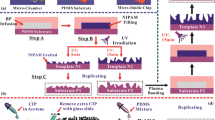Abstract
Hydrophilic-hydrophobic surface is vital for the study of the wettability behavior of microdroplets. In this paper, a method for preparation of hydrophilic-hydrophobic patterned surface is proposed based on the oxygen inhibition effect. Oxygen inhibition is very common in photo-cured process, and usually should be avoided for its adverse effect on curing quality. However, it also results in numerous nanostructures naturally formed on the cured layer surface, and the density and sizes of the nanostructures can be modulated conveniently by adjusting the exposure time. Based on this phenomenon, the cured layer surface having hydrophobicity can be processed. The contact angle system is used to measure the contact angle of the cured layer surface, and the morphology of the cured layer surface is measured in detail by atomic force microscopy and scanning electron microscope.The hydrophobic layer is only 1.5 \(\upmu \)m thick. By combining maskless lithography, patterned surface with nanostructures can be easily formed in just one step without any special treatment. This helps us to generate highly controllable hydrophilic-hydrophobic surface effectively in a very simple and low-cost way. With this method self-assembled droplet microarrays are successfully achieved. The results offer a new idea for the control of surface wettability and may find wide potential applications in microfluidics.








Similar content being viewed by others
References
Y.P. Hou, S.L. Feng, L.M. Dai, Y.M. Zheng, Droplet manipulation on wettable gradient surfaces with micro-nano-hierarchical structure. Chem. Mater. 28(11), 3625–3629 (2016)
O. Al-Khayat, J.K. Hong, D.M. Beck, A.I. Minett, C. Neto, Patterned polymer coatings increase the efficiency of dew harvesting. ACS Appl. Mater. Interfaces 9(15), 13676–13684 (2017)
W. Feng, E. Ueda, P.A. Levkin, Droplet microarrays: from surface patterning to high-throughput applications. Adv. Mater. 30(20), 1706111 (2018)
J. Zhang, J. Liu, Z. Yu, S. Chen, O.A. Scherman, C. Abell, Patterned arrays of supramolecular microcapsules. Adv. Funct. Mater. 28(20), 1800550 (2018)
A.H. Kunding, L.L. Busk, H. Webb, H.W. Klafki, M. Otto, J.P. Kutter, M. Dufva, Micro-droplet arrays for micro-compartmentalization using an air/water interface. Lab Chip 18(18), 2797–2805 (2018)
D. Park, M. Kang, J.W. Choi, S.M. Paik, J. Ko, S. Lee, Y. Lee, K. Son, J. Ha, M. Choi et al., Microstructure guided multi-scale liquid patterning on an open surface. Lab Chip 18(14), 2013–2022 (2018)
P. Samyn, M. Biesalski, O. Prucker, J. Ruehe, Dewetting and photochemical crosslinking of adhesive pads onto lithographically patterned surfaces. J. Appl. Polym. Sci. 136(15), 47321 (2019)
I. Nayshevsky, Q.F. Xu, A.M. Lyons, Hydrophobic-hydrophilic surfaces exhibiting dropwise condensation for anti-soiling applications. IEEE J. Photovolt. 9(1), 302–307 (2018)
W. Feng, L. Li, E. Ueda, J. Li, S. Heiler, A. Welle, O. Trapp, P.A. Levkin, Surface patterning via thiol-yne click chemistry: an extremely fast and versatile approach to superhydrophilic-superhydrophobic micropatterns. Adv. Mater. Interfaces 1(7), 1400269 (2014)
D. Xuemin, J. Wang, H. Cui, Q. Zhao, H. Chen, L. He, Y. Wang, Breath-taking patterns: discontinuous hydrophilic regions for photonic crystal beads assembly and patterns revisualization. ACS Appl. Mater. Interfaces 9(43), 38117–38124 (2017)
C.-Y. Chen, H.-H. Li, H.-Y. Chu, C.-M. Wang, C.-W. Chang, L.-E. Lin, C.-C. Hsu, W.-S. Liao, Finely tunable surface wettability by two-dimensional molecular manipulation. ACS Appl. Mater. Interfaces 10(48), 41814–41823 (2018)
C. Decker, A.D. Jenkins, Kinetic approach of oxygen inhibition in ultraviolet-and laser-induced polymerizations. Macromolecules 18(6), 1241–1244 (1985)
C.E. Corcione, R. Striani, M. Frigione, Uv-cured methacrylic-silica hybrids: Effect of oxygen inhibition on photo-curing kinetics. Thermochim. Acta 576, 47–55 (2014)
A.S. Gladman, E.A. Matsumoto, R.G. Nuzzo, L. Mahadevan, J.A. Lewis, Biomimetic 4d printing. Nat. Mater. 15(4), 413 (2016)
A. Vitale, M. Quaglio, A. Chiodoni, K. Bejtka, M. Cocuzza, C.F. Pirri, R. Bongiovanni, Oxygen-inhibition lithography for the fabrication of multipolymeric structures. Adv. Mater. 27(31), 4560–4565 (2015)
M.-J. Lee, M.-J. Kim, J.-S. Kwon, S.-B. Lee, K.-M. Kim, Cytotoxicity of light-cured dental materials according to different sample preparation methods. Materials 10(3), 288 (2017)
S.C. Ligon, B. Husar, H. Wutzel, R. Holman, R. Liska, Strategies to reduce oxygen inhibition in photoinduced polymerization. Chem. Rev. 114(1), 557–589 (2013)
R. Janusziewicz, J.R. Tumbleston, A.L. Quintanilla, S.J. Mecham, J.M. DeSimone, Layerless fabrication with continuous liquid interface production. Proc. Natl. Acad. Sci. 113(42), 11703–11708 (2016)
J.R. Tumbleston, D. Shirvanyants, N. Ermoshkin, R. Janusziewicz, A.R. Johnson, D. Kelly, K. Chen, R. Pinschmidt, J.P. Rolland, A. Ermoshkin, Continuous liquid interface production of 3d objects. Science 347(6228), 1349–1352 (2015)
H.E. Jeong, R. Kwak, A. Khademhosseini, K.Y. Suh, Uv-assisted capillary force lithography for engineering biomimetic multiscale hierarchical structures: from lotus leaf to gecko foot hairs. Nanoscale 1(3), 331–338 (2009)
J. Qiu, M. Li, H. Ye, J. Zhu, C. Ji, Fabrication of high fill-factor microlens array using spatially constrained thermal reflow. Sens. Actuators A Phys. 279, 17–26 (2018)
R.N. Wenzel, Resistance of solid surfaces to wetting by water. Ind. Eng. Chem. 28(8), 988–994 (1936)
H. Li, Y. Sirong, W. Xie, X. Han, X. Wang, A study about the influence of single-scale and dual-scale structures on surface wettability. Appl. Phys. A 123(5), 374 (2017)
A.B.D. Cassie, S. Baxter, Wettability of porous surfaces. Trans. Faraday Soc. 40, 546–551 (1944)
P.M. Johnson, J.W. Stansbury, C.N. Bowman, Photopolymer kinetics using light intensity gradients in high-throughput conversion analysis. Polymer 48(21), 6319–6324 (2007)
Acknowledgements
This work was supported by funding from the National Natural Science Foundation of China (Grant No. 51475442), the Fundamental Research Funds for the Central Universities, and partially carried out at the University of Science and Technology of China Center for Micro and Nanoscale Research and Fabrication.
Author information
Authors and Affiliations
Corresponding author
Additional information
Publisher's Note
Springer Nature remains neutral with regard to jurisdictional claims in published maps and institutional affiliations.
Rights and permissions
About this article
Cite this article
Chen, P., Li, M., Qiu, J. et al. Oxygen inhibition induced hydrophilic-hydrophobic surface for self-assembled droplet microarrays. Appl. Phys. A 126, 645 (2020). https://doi.org/10.1007/s00339-020-03830-w
Received:
Accepted:
Published:
DOI: https://doi.org/10.1007/s00339-020-03830-w




